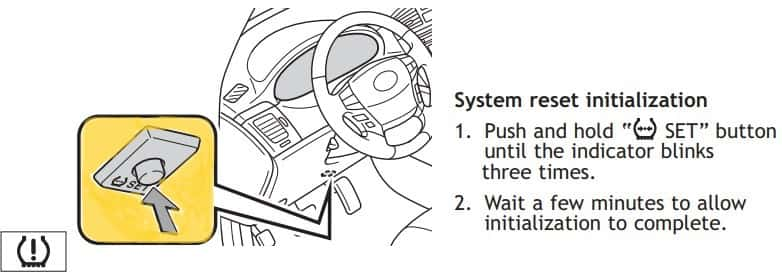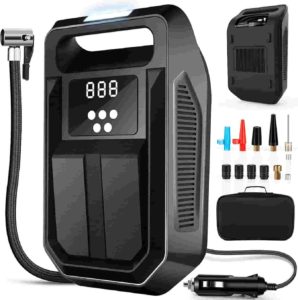What is the TPMS in the Toyota Avalon?
The Tire Pressure Monitoring System (TPMS) in the Toyota Avalon is a feature designed to keep track of the air pressure within your vehicle’s tires. If the pressure in any tire falls below the recommended level, the TPMS will trigger a warning light on your dashboard. This system aims to help maintain optimal tire pressure for better fuel efficiency, longer tire life, and safer driving conditions.
How Does the Toyota Avalon TPMS Work?
The Tire Pressure Monitoring System (TPMS) in the Toyota Avalon is a vital part of ensuring a safe and efficient driving experience. By providing real-time data regarding the tire pressure on each wheel, it ensures that you always drive with the appropriate tire inflation, thus optimizing performance and safety.
The TPMS in your Toyota Avalon works through a direct tire pressure system. The direct TPMS features a small sensor in each tire that measures the actual pressure. These sensors are part of the valve stem and are powered by small, built-in batteries. They relay radio frequency signals to the TPMS control module, also known as the ECU (Electronic Control Unit). Each sensor has its own unique ID, so the system can differentiate between each of your vehicle’s tires.
If the TPMS detects a tire with low pressure ( defined as 25% below Toyota’s listed pressure), it triggers a warning light on the dashboard. In newer Toyota Avalon models the TPMS warning light activates and the multi-information display will also provide a readout of the actual pressure in each tire.
Beyond just monitoring, the TPMS in the Toyota Avalon includes a tire pressure warning reset switch. This allows the driver to recalibrate the system when the tires are inflated, rotated, or replaced, ensuring the TPMS is always working accurately based on the current state of the tires.
It’s worth noting that while the TPMS is an excellent tool for maintaining proper tire pressure, it should not replace regular manual checks. It’s important to manually check your tire pressure with a gauge at least once a month, as the TPMS may not alert you to gradual pressure loss that can affect fuel economy and tire wear.
Tire Pressure
How Does Weather Affect Tire Pressure?
The weather can significantly impact the tire pressure in your Toyota Avalon, particularly during extreme temperature fluctuations. When temperatures plunge, air contracts and decreases tire pressure. This is why on brisk winter mornings you might find your TPMS alerting you to low pressure. Conversely in hot weather, air expands and can increase tire pressure potentially overinflating your tires. Both scenarios can affect your car’s performance and safety. Therefore, it’s important to regularly check your tire pressure and adjust as necessary, regardless of what your Avalon’s TPMS might indicate, to account for these weather-induced changes. For every 10 degree change in temperature, your tire pressure will go in the same direction by about 1 Psi.
How to Check Tire Pressure
Purchase a Tire Pressure Gauge: These are readily available at most automotive parts stores. There are several types, including digital and analog (stick or dial) models.
Ensure Your Tires Are Cold: For the most accurate reading, check the tire pressure when your tires are ‘cold’ – this means the car has been parked for at least three hours and hasn’t been driven more than a mile or so. This will also prevent you from overinflating your tires.
Locate the Valve Stem: This is the small protruding piece of metal or rubber on the inside of your wheel rim. Remove the valve cap and keep it in a safe place.
Attach the Pressure Gauge: Press the tire pressure gauge onto the valve stem. If you’re using a digital gauge, the reading will display on the screen. If you’re using an analog stick-type gauge the stick will pop up to show the pressure, and if you’re using a dial gauge the needle will point to the pressure.
Read the Pressure: Note down the pressure reading. Ensure it matches with the recommended tire pressure for the Toyota Avalon. This can usually be found in the vehicle’s manual or on the sticker inside the driver’s side door jamb.
Repeat for All Tires: Repeat steps 3 to 5 for each tire, including the spare.
Adjust Tire Pressure If Needed: If the pressure is too high, let out some air while checking the pressure intermittently to avoid letting out too much. If the pressure is too low, add air at a gas station or with a home compressor until it reaches the recommended level.
Replace the Valve Caps: Screw the valve caps back on the valve stem on each tire to prevent dirt and moisture from getting inside.
What are the Impacts of Driving With Underinflated Tires?
Increased Fuel Consumption: Underinflated tires have more rolling resistance which means your Avalon engine has to work harder to keep the car moving, leading to higher fuel consumption.
Decreased Tire Lifespan: Underinflated tires will cause uneven wear with the tire wearing more on its edges. This can significantly decrease the tire’s lifespan causing more frequent replacements.
Poor Handling and Braking: An underinflated tire can affect the car’s handling and make the Avalon harder to control especially when turning. It can also increase stopping distances making it potentially less safe to drive.
Increased Risk of Tire Damage: Underinflated tires are more susceptible to damage such as punctures or blowouts, especially when driving at high speeds or over potholes.
Harsher Ride Quality: Underinflation can also lead to a harsher ride, making the car feel less comfortable and creating lots of road noise.
Increased Risk of Tire Blowout: When tires are underinflated they can build up excessive heat especially at high speeds which increases the risk of a tire blowout.
Toyota Avalon TPMS Light and Safety Considerations
What Can Cause the Tire Light in the Toyota Avalon to Turn On
Spare Tire: Driving with the spare tire on will cause the tire light to come on and stay on.
Seasonal temperature changes: A decrease in ambient air temperature can cause tire pressure to decrease, triggering the tire warning light.
Tire puncture or leak: A sharp object or road debris like a nail or screw can puncture a tire, causing air loss which will activate the tire warning light.
Faulty tire pressure sensor: Damaged or malfunctioning sensors may provide inaccurate readings causing false alerts. The only way to figure out which sensor is faulty is to scan each sensor with a TPMS diagnostic tool.
Tire damage: Impact from hitting a curb or driving over deep potholes can cause structural damage like tire bubbles, leading to pressure loss.
Sensor battery life: Tire pressure sensors are battery-powered, and over time, batteries die. This will cause your tire light to turn on and stay on.
Recent tire rotation or replacement: In the event of a recent tire rotation or replacement, the TPMS might necessitate recalibration to prevent incorrect warnings. There are instances where the car’s computer could mistakenly identify the front tires as being at the rear, and vice versa following a rotation.
Valve stem issues: A damaged or leaking valve stem can lead to gradual pressure loss and eventual activation of the tire pressure light. There is a rubber gasket in between the sensor base and valve stem that can deteriorate over time causing air to leak out.
Wheel or rim issues: Cracked, corroded or damaged wheels can lead to air leaks and pressure loss. This is very common with low profile tires because they offer less protection to the wheel.
Altitude changes: Changes in altitude, either ascending or descending can influence tire pressure and potentially set off the TPMS alert.
Natural pressure loss: Tires lose air pressure over time due to temperature changes and permeation. Tire dry-rot will happen to tires that sit.
Electrical problems or software issues within the car’s TPMS system. Occasionally the system may have a software update.
Is it Safe to Drive With the Tire Light On?
Avoid operating your Toyota Avalon if the tire pressure warning light is illuminated. This could pose a safety risk. Determining the cause of the warning light activation is critical. Could there be a foreign object such as a nail embedded in your tire? Is there a potential leak? Is the air escaping from your tire at a rapid or gradual rate? Is there a faulty tire pressure sensor not affecting the air pressure in any way? Sometimes it can be completely safe to drive the vehicle with the tire light on and sometimes it can be detrimental to your safety. Understanding the precise issue will assist you in assessing whether it’s safe to proceed with your journey and if so for how long.
Why is My tire Light on But My Tires Look Fine?
Despite your Toyota Avalon tires appearing fine at a glance, they may not be at the proper pressure. It’s crucial to check the air pressure of each tire, especially your spare to confirm they are at the correct levels. If the pressures are right, consider if there has been a significant shift in the weather lately. Does the tire warning light extinguish when you inflate the tires only to reilluminate when you begin to drive? This could indicate a leak in the tire. If all tires maintain the right pressure and aren’t deflating yet the warning light persists, the issue likely lies with a faulty tire pressure sensor. This malfunction is often due to the sensor’s battery depleting leading to a TPMS error.
What is the TPMS Malfunction Indicator?
Your Toyota Avalon also has a special warning light to alert you to potential issues with your tire pressure monitoring system (TPMS). This warning light lights a yellow exclamation point, identical to the tire warning light. If there is an issue with the TPMS, the light will flash for approximately one minute before staying on. This sequence will occur every time you start your car until the issue is resolved. So, when your tire light is blinking or flashing, the system may not be able to accurately detect low air pressure. So, a blinking tire pressure light typically signals a malfunction within the TPMS itself, rather than an actual air pressure concern.
What Causes a TPMS Malfunction?
Using non Toyota wheels or tires.
Interference from electronic devices operating on the same radio frequency could potentially hinder the TPMS’s operational efficiency.
If your Toyota Avalon has super dark window tints, they can potentially interfere with the radio signal transmission between the TPMS sensors and the Engine Control Unit (ECU).
If the tire pressure is extremely high.
If wheels without tire pressure sensors are installed on the car.
In the event of ice or snow accumulation on or surrounding the tire valves.
If the Toyota Avalon TPMS receiver module/ECU does not recognize new tire pressure sensors installed.
Toyota Avalon Tire Pressure Sensor Batteries
Every tire pressure sensor is powered by an integrated battery. It’s key to note that these batteries are not designed for replacement. Comparable to those found in watches, they are fixed to the sensor’s circuit board. When the battery’s life ends the entire sensor must be replaced since it’s inseparable from the circuit board. The lifespan of these batteries can fluctuate depending on factors such as driving conditions and climatic variations. Typically, the batteries in these sensors last approximately 5 to 10 years.
Managing and Troubleshooting the Toyota Avalon TPMS
How to Reset Toyota Avalon Tire Pressure Light (2005 - 2012 Toyota Avalon)
Fill all 4 tires including the spare tire with the cold recommended pressure.
Start the Avalon or have the power on.
Reach down under the steering wheel and push and hold the TPMS reset button.
Watch the dashboard as you hold the reset button and you will see the TPMS indicator light blink 3 times.
Once the TPMS indicator light stops blinking, release the TPMS button.
Drive the Toyota Avalon for a few miles at speeds over 25 Mph to complete the reset.
How to Reset Toyota Avalon Tire Pressure Light (2012 - 2021 Toyota Avalon)
Fill all 4 tires including the spare tire with the cold recommended pressure.
Use the arrows on the left side of the steering wheel.
Scroll down and select the Gear icon
Scroll all the way to the right and select Vehicle Settings.
Press and hold the OK button on the steering wheel
Select TPWS
Select Set Pressure
Drive the Toyota Avalon for a few miles at speeds over 25 Mph to complete the reset.
What Tools Do You Need to Reset the Toyota Avalon TPMS?
The only tool you need is an accurate tire pressure gauge. The reset procedure is built into the Toyota Avalon ECU.
When Should You Reset Your TPMS?
After Tire Rotations
After adjusting tire pressure
Any time a wheel or tire is removed and then put back on the Avalon.
After Replacing a Tire Sensor
After Purchasing New Tires
After Tire Balances or Alignments
Troubleshooting Tricks to Reseting Toyota Avalong Tire Light
Option 1: Spare Tire
Double check your spare tire. The spare tires in the Toyota Avalon have their own tire pressure sensor. This means that if the spare tire is low on air, the tire light will illuminate. Even if the spare tire is not currently mounted on the vehicle, if the spare tire is low on air, the tire light will turn on. This is very common on Toyota Avalons.
Option 2: Is the Tire Losing Air?
If the light doesn’t go off right away, re-check your tire pressure to make sure they are all at the exact pressure you set them to. If only one out of 4 tires is low on air, you probably have some sort of tire leak. Read the section on “identifying a tire leak” to learn how to find where your tire is leaking from.
Option 3: Overfill the Tires
If the pressures are at the exact pressure you set them to and the tire light still won’t go off, over fill your tires to wake up the sleeping sensor. We recommend filling your problem tire with about 45 Psi or about 10 Psi over the cold recommended pressure. With the tire overfilled, drive the Toyota again for 10 or 15 minutes. After the tire light goes off, readjust the pressure back to the recommended pressure.
Option 4: Reset the Toyota Avalon ECU
Assuming your tires aren’t leaking and the spare tire is filled with the correct pressure, you can manually delete the error codes stored in the vehicle’s ECU. Achieve this by detaching the negative terminal from the main 12-volt battery. After waiting for a brief period, reconnect the terminal. This action will clear all error codes from the ECU, including the tire pressure error code that triggers the tire warning light.
How to Install and Program New TPMS Sensors
First, remove the wheel from your Toyota Avalon then take off the tire to access the sensor. Remove the old sensor and valve stem. When installing the new sensor, take a photo of its ID code, which might be needed later. Confirm the new sensor works with the Avalon’s ECU. Use a valve removal tool to pull the new valve through the wheel’s valve hole. After installing the new sensor and remounting the tire you need to program the sensor with the TPMS. You’ll need a TPMS programming tool for this. Scan each tire sensor, then connect the tool to the car’s OBD2 port and the programming tool will relearn the new sensor to the Avalons computer.
Tire Leaks and Solutions
How to Find a Tire Leak
To detect a tire leak in your Avalon, start by examining the air pressure in all tires to identify the one that’s low. Inflate the underinflated tire as it’s impossible to locate a leak in a deflated tire. Then mix a solution of soap and water in a spray bottle (or use Windex) and generously spray it over the entire tire. Don’t forget to spray the soapy water on the valve stem and bead seal. Ensure the tire is thoroughly soaked. Wait for a bit and then meticulously inspect the tire for any small bubbles. If there’s a leak, the escaping air will create tiny bubbles where the soapy water was sprayed. Patience is key in finding these bubbles. If the tire is losing air, a leak is definitely present so keep spraying and searching for that leak!
Are Tire Plugs Safe?
Yes! I’ve used tire plugs hundreds of times to fix tires working at tire shops and they work great! They’re good for fixing tire holes and punctures. They seal the hole and stop air from leaking out. (But don’t forget to take out the thing that caused the hole.) Tire plugs are made of tough materials that can handle changes in air pressure and temperature within the tire. If put in right, a tire plug can last as long as the tire does. Just remember, don’t use tire plugs to fix the tire’s sidewall.
Are Tire Sealants Safe?
Tire sealants should only be used in emergency situations. They can destroy your tire pressure sensors and damage the tire. (this can be costly!) This is because they can throw off the tire’s balance, which can cause the steering wheel to vibrate when driving. So, it’s best not to use tire sealants unless you really need to. If you do use one, take your Toyota Avalon to a tire shop as soon as you can!
TPMS and Legal Considerations
Are TPMS Sensors Legally Required in the Toyota Avalon?
In many parts of the world, including the United States and Europe, it’s legally required for vehicles to have tire pressure monitoring system (TPMS) sensors. The TREAD Act, established in the U.S. in 2000, mandates that all vehicles manufactured after September 2007 must be equipped with a TPMS. This law is aimed primarily at vehicle manufacturers and is designed to improve road safety by alerting drivers to significant tire pressure changes. Likewise, since November 2012, European regulations require all new passenger vehicles to come with a TPMS. These rules are intended to reduce the number of accidents caused by tire-related issues.
Will the Toyota Avalon Pass State Inspection With the Tire Light On?
Indeed, your Toyota Avalon will still pass inspection even if the tire pressure light is on. This largely depends on the specific rules in your state. As a certified inspector in New Jersey, I can confirm that a working TPMS isn’t mandatory for passenger vehicles to pass inspection in our state, even if the tire pressure light is active.







